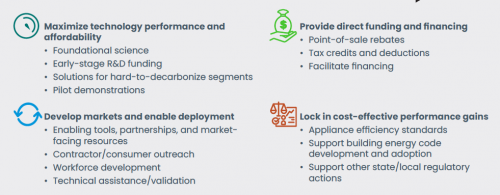DOE Blueprint for Decarbonizing the Buildings Sector
The Department of Energy just published a Blueprint for Decarbonizing the Buildings Sector. This is all about succeeding with CCL's policy area of building electrification and efficiency, including making buildings more efficient through weatherization measures and replacing fossil fuel heating with electric heat pumps. The report notes that efficiency is particularly important to minimize strain on the electrical grid. And technologies like smart thermostats and appliances can help with that too.

Rebates and tax credits for electrification and efficiency – like those provided in the Inflation Reduction Act – are identified as key measures. Strengthening appliance efficiency standards and building energy codes will also be important tools, as well as funding research into cleaner and more efficient technologies.

The blueprint also breaks the building decarbonization transition into 3 distinct phases:
Before 2030, federal action must focus on catalyzing the transition. Examples include reducing the cost of heat pumps, improving public awareness of low-carbon solutions and their benefits, providing technical assistance and workforce training, and leading by example with federal facility decarbonization.
The next stage from 2030 to 2040, focuses on adapting and scaling, with efforts to update market integration support, incentives, and training resources for high-impact technologies and to expand federal facility upgrades consistent with Administration goals.
The final stage, from 2040 to 2050, will complete the transition through activities such as enabling technology adoption and prioritizing retrofits in lagging segments and addressing remaining emissions from combustion and material life cycles.
And the report also discusses the many other benefits that come with decarbonizing buildings by installing heat pumps and replacing dirty fossil fuel appliances:
Reducing on-site fossil-fired building emissions is often cited as a key component of economy-wide decarbonization, and building electrification with heat pumps is a primary strategy for doing so. The potential benefits of building electrification go beyond emissions reductions and include improved indoor air quality, reduced construction costs, new jobs creation, and less exposure to increases in fossil fuel prices.
Some key barriers include local electrical grid capacity to handle building electrification (which is tied to another of our policy areas – permitting reform), upfront equipment costs, making sure contractors are trained in clean technologies, and a lack of consumer awareness. But these are all surmountable challenges 🤓
Search Forums
Forum help
Select a question below
CCL Community Guidelines
- Discuss, ask and share
- Be respectful
- Respect confidentiality
- Protect privacy
CCL Blog Policy Area Categories
- Price on Carbon
- CBAM
- Clean Energy Permitting Reform
- Healthy Forests
- Building Electrification and Efficiency



